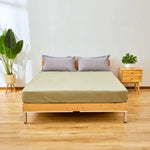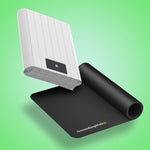
Grounding mats offer a simple way to bring the Earth’s natural energy indoors, helping your body stay calm, balanced, and supported throughout the day. At GroundingWell, we believe that grounding should blend seamlessly into your lifestyle, no matter your schedule or routine. Choosing the right places in your home to use a grounding mat can enhance its benefits and make grounding an effortless daily habit.
Table of Contents
- Key Takeaways
- Why Placement Matters?
- 1. Under Your Desk While You Work
- 2. In the Bedroom
- 3. In the Living Room
- 4. In the Home Office
- 5. In the Kitchen
- 6. In the Yoga or Exercise Area
- 7. Portable Use Around the Home
- Tips for Getting the Most Out of Your Grounding Mat
- Conclusion
- FAQs:
Key Takeaways
- Grounding mats work best in areas where you spend long periods
- Using grounding indoors may support sleep, reduce stress, and improve focus
- Placement options vary based on your routine and comfort preferences
- Several studies support grounding’s potential benefits on stress and recovery
- GroundingWell mats make at-home grounding simple, safe, and accessible
Why Placement Matters?
Grounding works best when your skin maintains steady contact with the conductive surface. Choosing spots where you naturally spend time increases your exposure without changing your routine. Grounding improves your health by supporting moments of rest, focus, or recovery, when the body is more open to calming electrical balance. Adding grounding to these everyday moments strengthens consistency and helps your system benefit from a steady flow of natural energy.
Key reasons placement matters:
- Ensures longer, uninterrupted grounding sessions
- Fits grounding into your daily habits without extra effort
- Supports relaxation, mental clarity, and physical recovery
- Helps maintain a stable grounding routine over time
- Encourages better results through consistent practice
Understanding the best places to use a grounding mat can help you maximize its benefits and incorporate it seamlessly into your daily routine.
1. Under Your Desk While You Work
Spending hours at a desk, whether working from home or studying, can lead to stress, fatigue, and tension. Using a grounding mat under your feet or on your chair can help you stay connected to the Earth while you focus.
Benefits of using a grounding mat at your desk include:
- Reduced stress and mental fatigue by promoting calm and relaxation.
- Improved posture and circulation when placed under your feet while sitting.
- Increased focus and energy levels, which may help during long work or study sessions.
For desk use, place the mat under your feet or on your chair seat, ensuring direct skin contact. This setup allows electrons from the Earth to flow into your body, helping balance your energy throughout the day.
2. In the Bedroom
The bedroom is one of the most popular places for grounding mats because sleep is a time when your body performs natural repair and restoration processes. Using a grounding mat at night can complement other sleep hygiene practices.
How grounding mats benefit sleep:
- Improves sleep quality by reducing cortisol levels and calming the nervous system.
- Reduces nighttime muscle tension and minor aches that may disturb rest.
- Supports overall relaxation, making it easier to fall asleep and stay asleep.
Place the mat under your bed sheets or mattress pad, ensuring at least part of your body is in direct contact with it while lying down. Some people also place it under their feet while sleeping if a full-body mat isn’t available.
3. In the Living Room
Many people spend hours in the living room watching TV, reading, or relaxing. Adding a grounding mat to your favorite chair, sofa, or floor spot can extend the benefits of earthing beyond sleep and work.
Benefits in the living room include:
- Enhanced relaxation during downtime or leisure activities.
- Reduced stress and tension after a long day.
- Potential relief from inflammation or mild discomfort in joints and muscles.
To use a grounding mat in the living room, place it where you frequently rest your feet or sit. Mats are flexible and portable, making it easy to switch between areas as needed.
4. In the Home Office
For those working from home, a grounding mat in the office area can improve both productivity and well-being. Since many of us spend extended hours sitting at a computer, reconnecting with the Earth’s energy can offset the effects of prolonged sedentary activity.
Reasons to use a grounding mat in your home office:
- Decreases mental fatigue by promoting calm and reducing stress hormones.
- Supports healthy circulation, especially when sitting for long periods.
- Provides a subtle energy boost, which can improve focus and motivation.
Place the mat under your desk where your feet rest, or position it on the floor beneath your chair. For added benefits, you can place your palms on the mat during breaks to increase the earthing effect.
5. In the Kitchen
Although less common, using a grounding mat in the kitchen can have surprising benefits. Many people spend a lot of time standing while cooking, cleaning, or preparing meals. Grounding while standing can reduce tension in your legs and back.
Advantages of a grounding mat in the kitchen:
- Reduces fatigue and discomfort from standing for extended periods.
- Supports circulation in the legs and feet.
- Promotes a sense of calm in a space that can often be busy and stressful.
Choose a mat that is designed for standing use, and place it in front of the stove, sink, or food prep area. Make sure it’s non-slip for safety and provides a comfortable surface to stand on for extended periods.
6. In the Yoga or Exercise Area
If you have a home gym or a yoga practice, exercise space, grounding mats can enhance both physical and mental benefits during your routines. Connecting to the Earth during stretching, meditation, or light exercise can amplify relaxation and recovery.
Benefits of grounding mats in exercise areas:
- Supports recovery by reducing inflammation condition after workouts.
- Promotes calm and mental focus during meditation or yoga.
- Provides a stable, grounded surface for barefoot exercises.
Use the mat during yoga sessions, meditation, stretching routines, or light workouts. Direct skin contact is essential, so barefoot or hands-on positioning works best.
7. Portable Use Around the Home
One of the biggest advantages of grounding mats is their portability. They can easily be moved from one room to another to match your daily routine.
Tips for portable use include:
- Carry it between rooms to enjoy grounding while working, relaxing, or exercising.
- Use smaller mats for specific body areas like under the feet, hands, or back.
- Combine mats for full-body grounding if desired.
A flexible, portable grounding mat allows you to incorporate earthing naturally into multiple areas of your home without permanent installation.
Tips for Getting the Most Out of Your Grounding Mat
To maximize your results:
- Keep direct skin contact when possible
- Use the mat consistently each day
- Place it in high-use areas
- Start with 20–30 minutes, then increase as desired
- Follow the setup guidelines included with your GroundingWell product
Conclusion
A grounding mat can become one of the most supportive tools in your home, helping you stay centered, calm, and connected to the Earth without changing your routine. By choosing the right placement, you can enjoy grounding during the moments you relax, focus, and recharge. At GroundingWell, our mission is to make grounding practical and accessible for every household. If you’re ready to enhance your daily wellness or personalize your grounding routine, contact us today for guidance and product support.
FAQs:
Where should I put my grounding mat at home?
The best places include your desk, bedside, meditation space, living room, or home gym, areas where you spend consistent time.
Do grounding mats really work?
Research suggests grounding may support stress reduction, sleep quality, and inflammation balance.
Can I use a grounding mat while working?
Yes. Many people place the mat under their desk to stay grounded for several hours each day.
Do grounding mats work through socks?
Bare skin contact is ideal, though thin socks can still allow some conductivity.
Is it safe to use grounding mats indoors?
Yes. They connect to grounded outlets designed to deliver safe electrical pathways.
How long should I ground each day?
Most people start with 20–30 minutes and gradually increase time as grounding becomes part of their routine.








